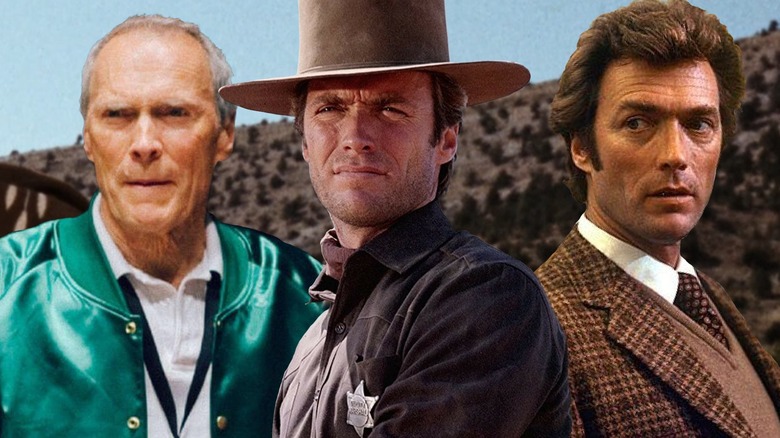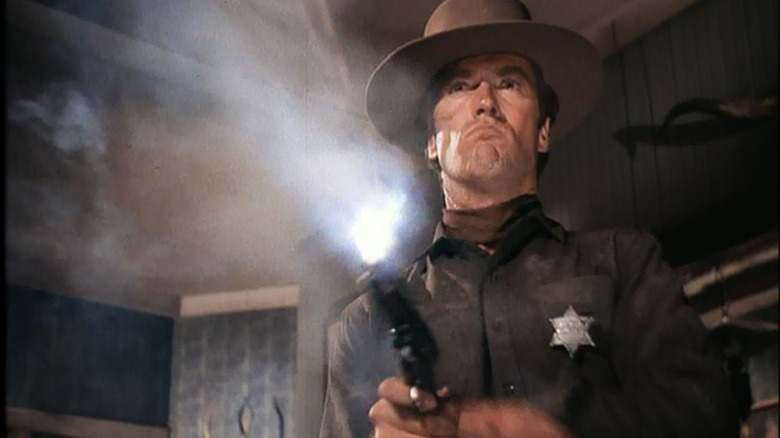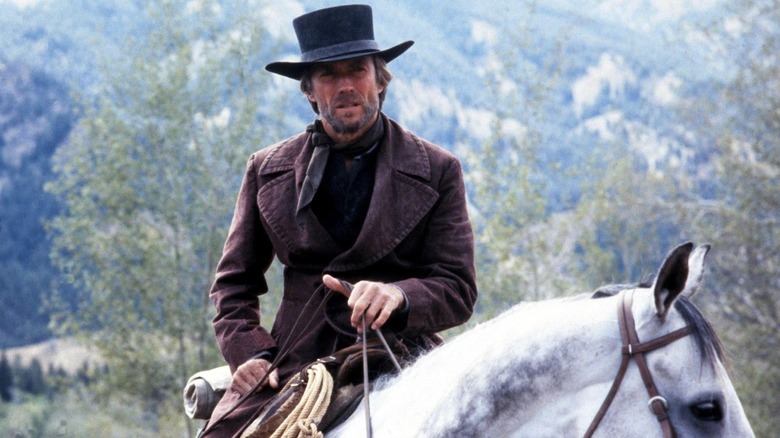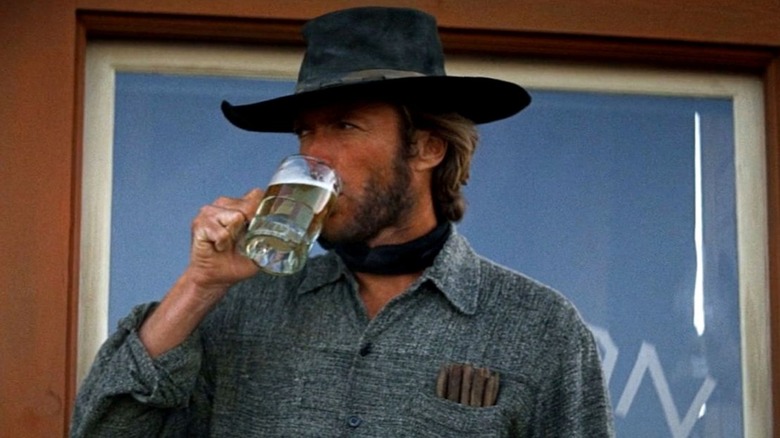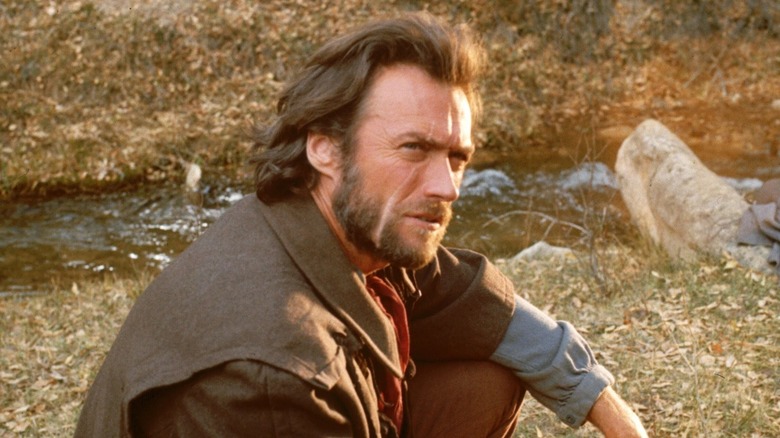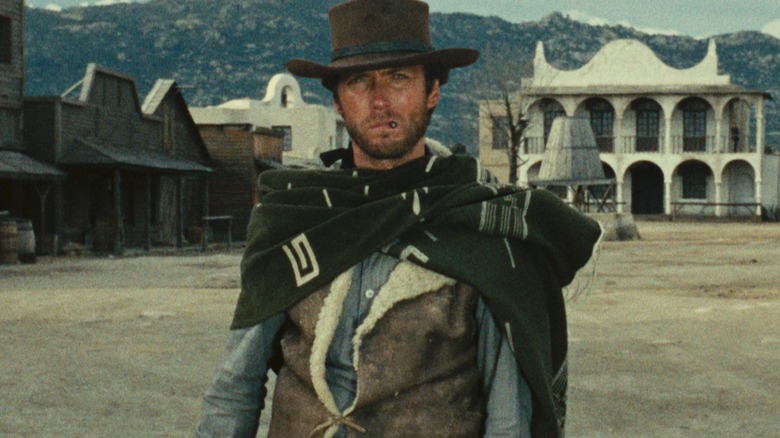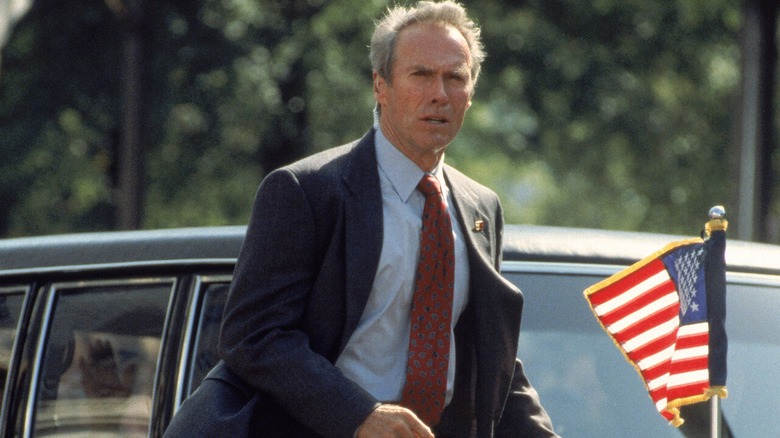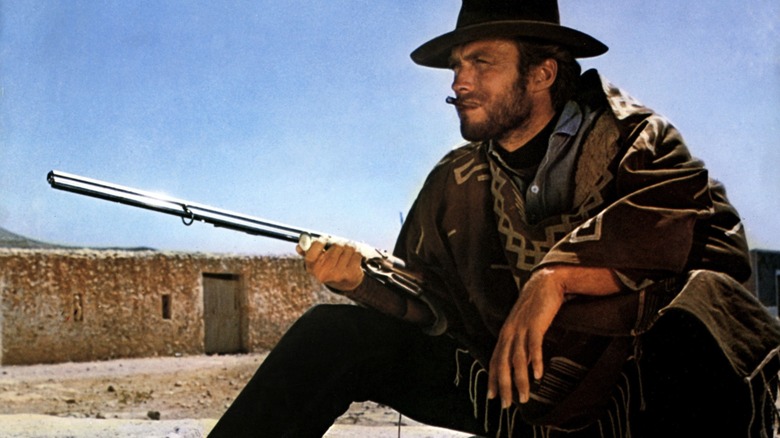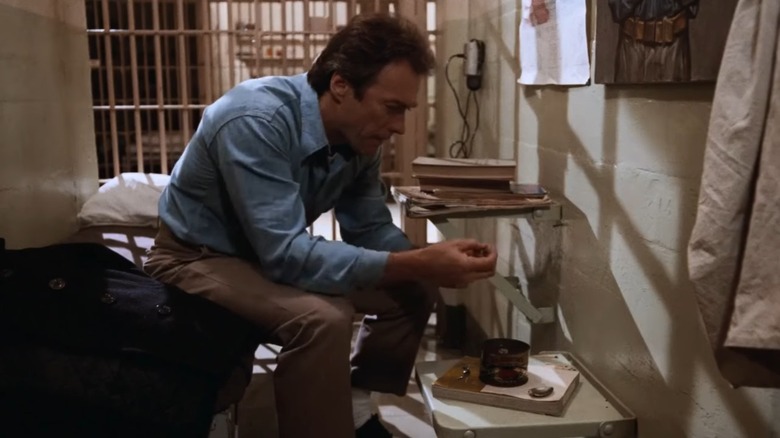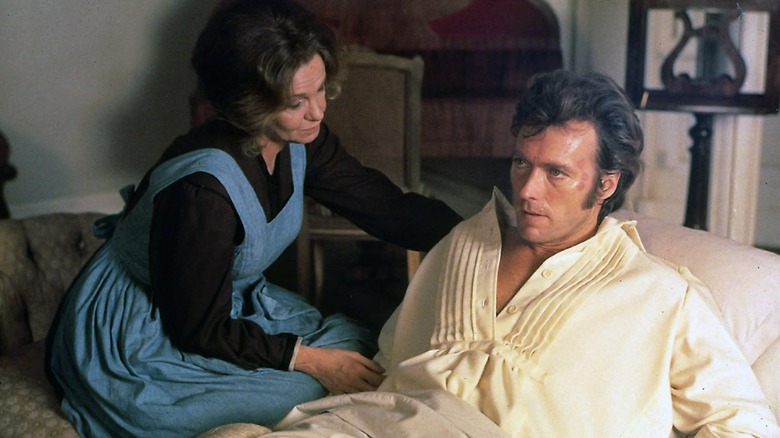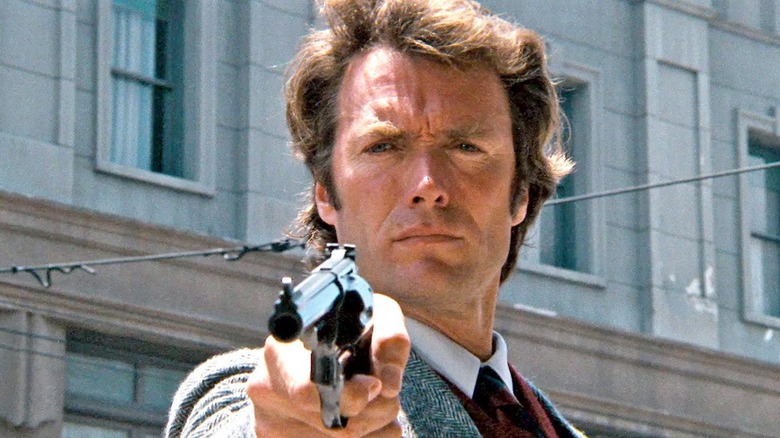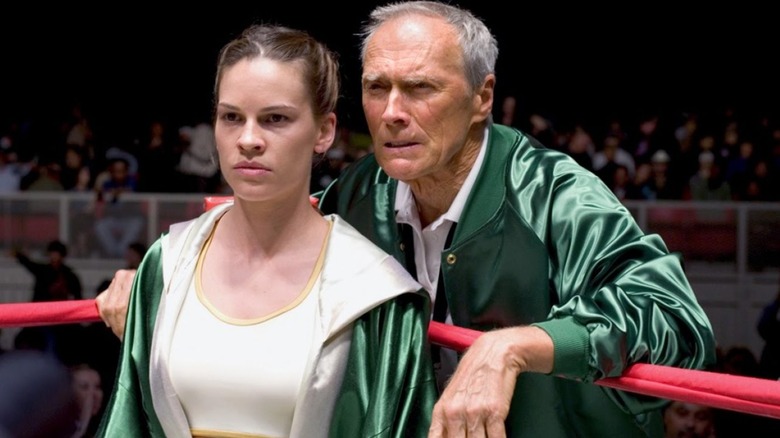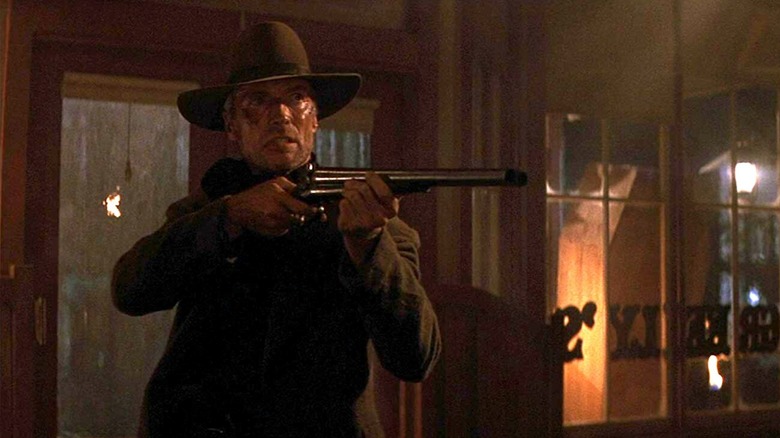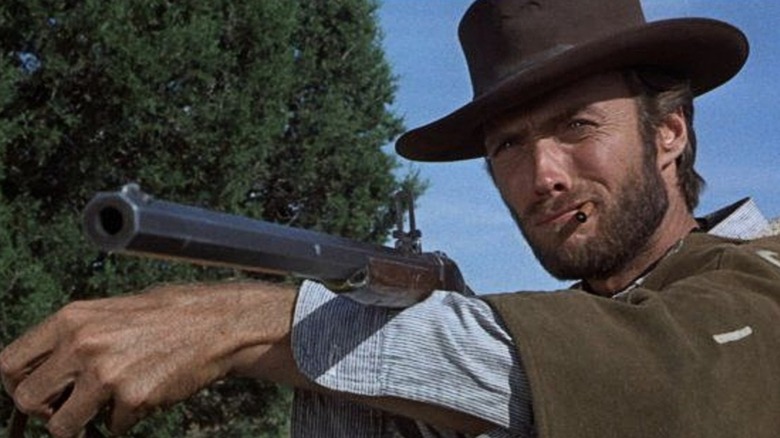13 Best Clint Eastwood Movies, Ranked
We may receive a commission on purchases made from links.
Clint Eastwood is Hollywood royalty, having worked in the movie industry since 1955's "Revenge of the Creature." He spent the 1950s and '60s appearing in various uncredited roles, but it wasn't until he played Joe in 1964's "A Fistful of Dollars" that people began taking notice. Eastwood, alongside famed Italian director Sergio Leone, helped usher in the Spaghetti Western subgenre, which made him an international superstar.
Between 1971 and '74, Eastwood had a seven-film streak of highly rated movies. His incredible ability to dominate every scene he's in is a skill few actors can ever hope to achieve. As he got older, Eastwood branched out, working as a producer and director. His first attempt at directing came in 1971's "Play Misty for Me," and in 1993, he took home the Academy Award for best director for "Unforgiven."
Eastwood wears many hats in Hollywood and continues working well into his 90s. He directed "Juror #2" at the age of 92, and he continues to tell stories, act in films, and dominate Hollywood long after most would have retired. Eastwood acted in some of the greatest movies ever, but determining which are the best is subjective. Here are Eastwood's 13 best movies, ranked by an aggregate of their IMDb, Rotten Tomatoes, and Metacritic scores.
Hang 'Em High
"Hang 'Em High" begins in Oklahoma in 1889, where retired lawman Jed Cooper (Clint Eastwood) finds himself the target of a posse hunting down cattle rustlers. They don't believe Cooper's innocence and lynch him, but he survives, setting the stage for a fantastic revenge film that sees Eastwood in his first non-Spaghetti Western as the lead. After Cooper is saved by a passerby, he's exonerated and made a deputy marshal by a judge.
This puts him on the side of law and order, and he tracks down the territory's deadliest outlaws. Initially, he doesn't look for the nine men who lynched him because the judge forbids Cooper from taking the law into his own hands. This changes when Captain Wilson (Ed Begley), the posse's leader, shoots Jed in an attempt to protect himself, but Cooper again survives.
This only enrages Cooper, who goes on the hunt to track down Wilson and his supporters. The film is an excellent Western in Sergio Leone's style, which influenced director Ted Post, who previously worked with Eastwood on "Rawhide." It's also Eastwood's first production credit, though it wouldn't be his last. Decades after its release, "Hang 'Em High" is a highly respected film, which Roger Ebert gave three stars.
Pale Rider
Clint Eastwood directed, produced, and starred in 1985's "Pale Rider," a title that references the Four Horsemen of the Apocalypse. Eastwood plays Preacher, a man who rides a pale horse, representing Death. "Pale Rider" is set in LaHood, California, but was actually filmed in that state and Idaho, showcasing the picturesque Sawtooth Mountains. It follows the enigmatic Preacher, who arrives in town after Coy LaHood (Richard Dysart) employs outlaws to terrorize gold miners into giving up their territory.
Preacher successfully fends off the attacks and attempts to negotiate with LaHood, but the miners refuse to settle things without violence, choosing instead to unleash Marshall Stockburn (John Russell) to take down Preacher, LaHood, and his men. The film hearkens back to the 1960s era dominated by Spaghetti Westerns, though it's an American production.
In this capacity, it's incredibly violent and unforgiving of pretty much everyone involved as Preacher truly embodies the manifestation of Death unleashed upon the world. It's also one of many films in which Eastwood plays an unnamed character, which is something he's done throughout his career making Westerns. As such, he's mysterious and dangerous — a man who cannot be killed by normal means alone, which is also what makes "Pale Rider" such an impressive film.
High Plains Drifter
Clint Eastwood directed "High Plains Drifter," playing a character called the Stranger, who rides into the isolated town of Lago. He's immediately threatened by three gunmen, and without breaking a sweat, he kills them all. It's fair to say that the Stranger isn't entirely on the side of good — he sexually assaults a woman who insults him, but he has a reason for his heinous crimes, and it's to do with vengeance.
He's in Lago to mete out some frontier justice against the people who killed U.S. Marshal Jim Duncan (Buddy Van Horn), and he doesn't hold back. He takes a job to protect the town, having killed the three men who previously held the position, and steers its inhabitants toward their own demise. It's a slaughter, and he wastes little effort killing just about everyone who gets in his way.
What makes "High Plains Drifter" so fascinating isn't the violence or immorality on full display — it's the Stranger's identity. The film is something of a supernatural ghost story that implies he's the ghost of the slain Marshal, though this is never overtly stated in the movie. New York Times film critic Vincent Canby called it "part ghost story, part revenge Western, more than a little silly, and often quite entertaining."
The Outlaw Josey Wales
Clint Eastwood directed and played the eponymous lead in 1976's "The Outlaw Josey Wales," following the exploits of an unflinching gunfighter. Some who watch "The Outlaw Josey Wales" may wonder if it's based on a true story. It's not — and is more of a revisionist Western than anything else, taking place during and after the Civil War. Wales is a farmer-turned-soldier out for revenge to avenge the death of his family during the conflict.
He quickly transforms into one of the most feared gunfighters in the West, becoming the target of soldiers and bounty hunters. Throughout his exploits, Wales kills anyone who gets in his way or comes after him, but he also saves several women and children, proving he's more than a killer. This works in his favor toward the end of the film, and he follows the familiar cliché by riding off into the sunset.
"The Outlaw Josey Wales" is a revenge story, and it's satisfying to watch a farmer thrust into war go about finding and slaughtering the men responsible for killing his family and comrades in arms. It's also decidedly pro-Confederacy, focusing on the so-called Lost Cause Mythology that vilified the Union and propped up the Rebels, which is something few films depict as well.
A Fistful of Dollars
"A Fistful of Dollars" is a historically important film for three reasons: it's Clint Eastwood's first starring movie role, it's widely recognized as the first Spaghetti Western, and it's the first of director Sergio Leone's "Dollars Trilogy." The film was released in 1964 and cost around $200,000 to produce, which was a paltry sum even in the early 1960s. The film introduces Eastwood's Stranger character (the Man With No Name), whom he also portrayed in two sequels.
"A Fistful of Dollars" begins with the Stranger arriving at the town of San Miguel on the U.S. border with Mexico. He pits himself between two rival gangs to make money, deftly killing four men who insult him. The Stranger upends the town through his machinations, killing men on both sides. The movie ends with an iconic standoff and duel, and you can guess who wins.
The plot of "A Fistful of Dollars" is similar to that of director Akira Kurosawa's 1961 film "Yojimbo," making it an unofficial remake. Kurosawa's influence is on full display throughout the film, and the famed Japanese director sued, settling for 15% of the revenue, likely earning more for Leone's movie than his own. Regardless, the film is an iconic Western and is easily one of Eastwood's best.
In the Line of Fire
"In the Line of Fire" is a Wolfgang Petersen film that focuses on Secret Service Agent Frank Horrigan (Clint Eastwood). He failed to stop the Kennedy assassination, haunting him for decades. He's also taunted by a man (John Malkovich) who goes by several names, including Booth, hearkening back to John Wilkes Booth, who killed President Abraham Lincoln.
Booth taunts Horrigan about his failure to save Kennedy while outright insisting he will fail again as he plans to kill the current president. The film focuses on the manhunt for Booth, the protection of the president, and Horrigan's desperate hope to do his job and stop another presidential assassination. The best aspect of this film isn't merely Eastwood's portrayal of a harrowed man; it's the contrast of roles between his and Malkovich's.
The latter turns in a master class on how to portray a merciless villain in a film. Seeing these two together on screen is a gift, and the movie received three Academy Awards nominations. It's fair to say that Eastwood is amazing in this movie, but it's Malkovich who nabbed a best supporting actor nomination. Roger Ebert aptly wrote, "Thrillers are as good as their villains, and 'In The Line of Fire' has a great one."
For a Few Dollars More
"For a Few Dollars More" is the second film in director Sergio Leone's "Dollars Trilogy," which again features Clint Eastwood as the Man With No Name, though he's referred to as "Manco" In this film. He works as a bounty hunter alongside Col. Douglas Mortimer (Lee Van Cleef), and they're on the hunt for El Indio (Gian Maria Volonté).
Indio is as bad as a man can get, having raped and murdered his way throughout northern Mexico and the southwestern United States. He's troubled by some of his past actions ... but not enough to stop. Manco joins Indio's gang and begins to work against him from the inside as the outlaws attempt to steal a large deposit of cash from a bank in El Paso, Texas. Everything unfolds with a great deal of death and betrayal, as is expected in these kinds of movies.
"For a Few Dollars More" wasn't initially well received by critics, mostly for its over-the-top depiction of violence, which isn't toned down by any measure. In the years since, it's been hailed for what it is — a spectacular Spaghetti Western, though it's sandwiched between two films that are better known, reducing its familiarity to those new to the genre.
Escape From Alcatraz
Back in 1962, several prisoners escaped from Alcatraz Island, and "Escape From Alcatraz" tells that story, though with some fictional flourishes. The film was directed and produced by Don Siegel in one of his many collaborations with Clint Eastwood. The movie centers on Frank Morris (Eastwood), a career criminal who's managed to escape from several high-security facilities, and he's no more inclined to remain imprisoned at Alcatraz for as long as his sentence demands.
Morris meets several prisoners and ropes them into his plan for escape, which involves removing the concrete around a small grill in their cells. He and the others spend months chipping away at the wall with spoons, and they also create paper-mache dummies of themselves with their own hair to act as decoys during their escape. They successfully bust out, though their ultimate fate remains a mystery.
Not many actors from "Escape From Alcatraz" are still alive these days, but it features plenty of top-tier talent. The film is based on a book of the same name, which tells the true story of the only successful-ish prison break from the island. It ends by suggesting the men survived their escape, though their true fate remains unknown more than 60 years later.
The Beguiled
"The Beguiled" is the third collaboration between Clint Eastwood and director Don Siegel, which is an incredibly successful partnership in Hollywood history. The film is set in 1863 during the American Civil War, when Cpl. John McBurney (Eastwood), an injured Union soldier, is found by Miss Martha Farnsworth (Geraldine Page). Initially, Farnsworth wants to hand him over to the Confederates but allows him to recuperate at her school first.
Over time, McBurney bonds with the women at the school, who turn on one another in their efforts to win his affection. Before long, this includes Farnsworth, but he rejects her. Some shenanigans lead to the amputation of his leg, and things devolve from there. McBurney attempts to leave with one of the women but is stopped in a rather insidious manner.
"The Beguiled" is a rare example of Eastwood playing against type — he's not the hero of the story, nor is he a stranger out for vengeance. Instead, he's a troubled man with loose morals, who some would argue gets what's coming to him in this film, which explores themes of feminism. A 2017 remake by director Sofia Coppola leans more heavily into this, and though it does so successfully, it pales in comparison to the original.
Dirty Harry
"Dirty Harry" establishes Clint Eastwood as San Francisco Police Department Inspector "Dirty" Harry Callahan, which is one his most iconic roles. Eastwood returned to the role of Dirty Harry in four sequels, so it's a well he returned to quite a lot. The film is an action thriller focusing on a serial killer and sniper known as Scorpio, who randomly targets people from a great distance.
He refuses to stop his killing spree unless he is paid $100,000. Inspector Callahan is on the case, but before that happens, he foils a bank robbery, holding a robber at gunpoint with the classic Dirty Harry gun, his Smith & Wesson Model 29 revolver. This is when he first utters his famous line, asking the perp to ask himself, "'Do I feel lucky?' Well, do you, punk?"
Callahan hunts down Scorpio and utters the same line after capturing him at gunpoint. "Dirty Harry" is one of those police movies that's unlike almost every other one out there. Callahan is a rogue officer who is willing to take out a bad guy rather than bring him to justice. He's called "Dirty" for his unconventional and often violent methods, making him one of cinema's baddest — and therefore best — cops.
Million Dollar Baby
Clint Eastwood directed and starred in "Million Dollar Baby," playing Frankie Dunn, a wizened and cantankerous trainer who owns and operates a run-down boxing gym in Los Angeles. While Eastwood plays a prominent role, the film's central character is Margaret "Maggie" Fitzgerald (Hilary Swank), a waitress-turned-boxer whom Dunn agrees to train after his first choice drops him for someone else. He forms a fatherly relationship with Maggie, giving her the name "Mo Cuishle."
Maggie begins to win fights, scoring quick knockouts as she makes her way up the amateur circuit, though Dunn refrains from entering her in bigger matches. He eventually arranges a title fight in the WBA welterweight championship against a ruthless boxer. Some dastardly cheating ensues, and an unfortunate hospital stay costs Maggie her leg. In the end, Dunn lovingly reveals the meaning of her name as "My darling, and my blood."
"Million Dollar Baby" was a massive success for Eastwood and Swank, both of whom took home Academy Awards. It won best picture, best actress, and best director, while Morgan Freeman won best supporting actor. The film received high praise from critics, including the Chicago Sun-Times' Roger Ebert, who gave it four stars, writing, "Clint Eastwood's 'Million Dollar Baby' is a masterpiece, pure and simple."
Unforgiven
In 1992, Clint Eastwood directed and starred in one of the greatest Western films ever made: "Unforgiven." The film is set in Wyoming in 1881, where William Munny (Eastwood) is a retired gunslinger who joins the so-called "Schofield Kid" (Jaimz Woolvett) alongside his old pal, Ned Logan (Morgan Freeman) on a bounty-hunting job to find the outlaw who slashed a prostitute's face. She's offering $1,000 for the outlaw's death, and the three embark on their quest.
They find the town and are met by the corrupt Sheriff "Little" Bill Daggett (Gene Hackman), who mercilessly beats Munny. Logan and the Kid escape, taking Munny to the whorehouse to heal. They eventually find the outlaws and kill the bounty, but Logan is beaten to death and displayed back at the saloon. When Munny sees this, he unleashes death upon the town in an act of bloody vengeance rarely seen in a film.
The revenge tale is direct and brutal, making the ending of "Unforgiven" one of the most intense in cinematic history. Unsurprisingly, Eastwood took home the Academy Awards for best picture and director, while Hackman received the statue for best supporting actor, and Joel Cox won for best film editing. Jack Mathews of the Los Angeles Times wrote that "Unforgiven" is "The finest classical Western to come along since perhaps John Ford's 1956 "The Searchers," which is decidedly high praise.
The Good, the Bad and the Ugly
The final film in Sergio Leone's "Dollars Trilogy" (and arguably the best), "The Good, the Bad and the Ugly" sees Clint Eastwood return as the Man With no Name in his final outing as the enigmatic character. The film takes place throughout the American Southwest in 1862, at the height of the American Civil War. The Stranger is joined by Tuco Ramirez (Eli Wallach), a Mexican bandit of impressive skill, capable of taking on multiple gunfighters at once.
When Ramirez meets the Stranger, he nicknames him "Blondie," and they band together on the hunt for $200,000 in gold buried in Sad Hill Cemetery, though only Ramirez knows its name. Blondie learns the name of the grave where the treasure is buried, and they each hold a piece of the information needed to find the gold. They eventually come into conflict with a man known only as Angel Eyes (Lee Van Cleef), a mercenary on the hunt for the stolen Confederate gold, and in the end, they meet at the cemetery.
The film concludes with what is easily the greatest Mexican standoff in movie history. Leone uses beautiful cinematography, combining wide shots and extreme close-ups in a nearly 10-minute sequence that palpably builds the tension. "The Good, the Bad and the Ugly" is easily the greatest Spaghetti Western and the best Clint Eastwood movie ever put to film.
